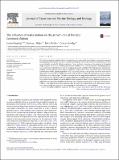Files in this item
The influence of water motion on the growth rate of the kelp Laminaria digitata
Item metadata
| dc.contributor.author | Kregting, Louise | |
| dc.contributor.author | Blight, Andrew J. | |
| dc.contributor.author | Elsäßer, Björn | |
| dc.contributor.author | Savidge, Graham | |
| dc.date.accessioned | 2016-03-03T10:40:05Z | |
| dc.date.available | 2016-03-03T10:40:05Z | |
| dc.date.issued | 2016-05 | |
| dc.identifier | 241405803 | |
| dc.identifier | c0615e92-3734-4f3e-bc34-deab314fbbb4 | |
| dc.identifier | 84959450134 | |
| dc.identifier | 000374200200011 | |
| dc.identifier.citation | Kregting , L , Blight , A J , Elsäßer , B & Savidge , G 2016 , ' The influence of water motion on the growth rate of the kelp Laminaria digitata ' , Journal of Experimental Marine Biology and Ecology , vol. 478 , pp. 86-95 . https://doi.org/10.1016/j.jembe.2016.02.006 | en |
| dc.identifier.issn | 0022-0981 | |
| dc.identifier.other | RIS: urn:0CFD8AC30F598726AA7E68AF23A5A296 | |
| dc.identifier.other | ORCID: /0000-0002-9665-8813/work/76386979 | |
| dc.identifier.uri | https://hdl.handle.net/10023/8355 | |
| dc.description | The work described in this paper was produced as part of SuperGen Marine Energy Research Consortium II, which was funded by the UK Engineering and Physical Science Research Council (grant number EP/E040136/1). | en |
| dc.description.abstract | The shallow water kelp Laminaria digitata, abundant in coastal zones of the North Atlantic, is exposed to a range of hydrodynamic environments that makes it ideal for assessing the role of water motion on their growth rate. Here we quantify the growth of L. digitata, as a factor of blade and stipe elongation, at sites adjacent to Strangford Lough, Northern Ireland under different hydrodynamic conditions over a one year period. A modelling approach was used to numerically determine both the temporal and spatial variability of the hydrodynamic environment. Ambient seawater nutrient concentrations, temperature and irradiance were measured as well as the internal nutrient status of the L. digitata populations. Kelp populations growing in the greatest and lowest water motion showed the lowest growth rates. Differences observed in growth rate could not be attributed to seawater nutrient availability, temperature or light. The internal nutrient status also suggested no influence on the observed differences in growth rate. Therefore if there are minimal differences in light, temperature and nutrients between sites, then populations of L. digitata exposed to different water motions are likely to exhibit different growth rates. It is suggested that the growth rate differences observed were a function of water motion with the possibility that, in response to the hydrodynamic forces experienced by the algal cells, L. digitata kelps in the high energy environments were putting more energy into strengthening cell walls rather than blade elongation. | |
| dc.format.extent | 10 | |
| dc.format.extent | 2861494 | |
| dc.language.iso | eng | |
| dc.relation.ispartof | Journal of Experimental Marine Biology and Ecology | en |
| dc.subject | Hydrodynamics | en |
| dc.subject | Light | en |
| dc.subject | Macroalgae | en |
| dc.subject | Nutrients | en |
| dc.subject | Productivity | en |
| dc.subject | NDAS | en |
| dc.title | The influence of water motion on the growth rate of the kelp Laminaria digitata | en |
| dc.type | Journal article | en |
| dc.contributor.institution | University of St Andrews. School of Biology | en |
| dc.contributor.institution | University of St Andrews. Sediment Ecology Research Group | en |
| dc.contributor.institution | University of St Andrews. Scottish Oceans Institute | en |
| dc.identifier.doi | 10.1016/j.jembe.2016.02.006 | |
| dc.description.status | Peer reviewed | en |
This item appears in the following Collection(s)
Items in the St Andrews Research Repository are protected by copyright, with all rights reserved, unless otherwise indicated.

